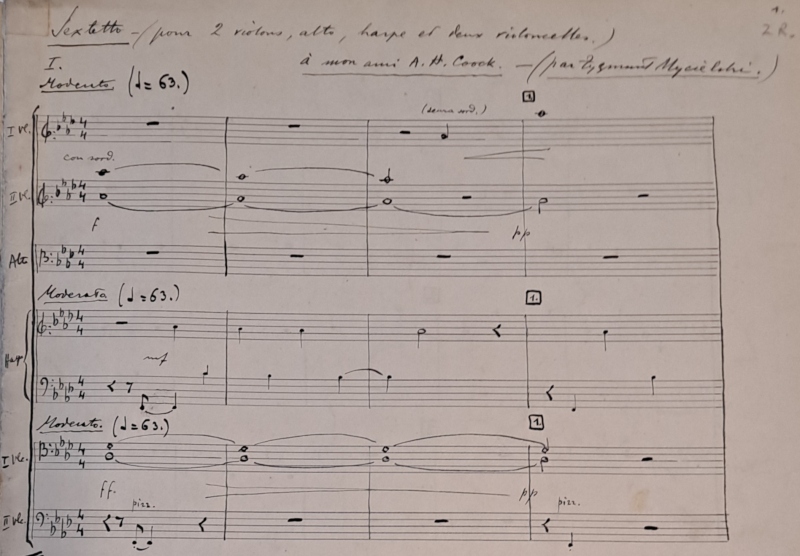
Sextet for two violins, viola, harp and two cellos (1932)
dedication: à mon ami A. H. Coock
duration: ca 12’
manuscript: Zygmunt Mycielski Archive, Manuscript Department, National Library, no. IV 14113 akc. 020504, IV 14114 akc. 020505, IV 14115 akc. 020506
premiere: ?
I. Moderato
II. Intermezzo. Larghetto
III. Thème populaire varié. Allegretto
In a 1933 survey documenting the progress of Nadia Boulanger’s students, Zygmunt Mycielski listed the following completed compositions: “songs (several cycles), piano pieces, pieces for piano and violin, piano and cello, two sextets, one trio, Lauda Sion based on Gregorian chant, instrumented songs etc.” (cf. Renata Suchowiejko, Muzyczny Paryż à la polonaise w okresie międzywojennym. Artyści – wydarzenia – konteksty, Wydawnictwo Księgarnia Akademicka, Kraków 2020, p. 287). Although the composer mentioned two sextets, the Zygmunt Mycielski Archive in the Manuscript Department of the National Library has only one; in addition, there are no traces of Lauda Sion or the instrumented songs. Mycielski dedicated the Sextet to his friend, probably a fellow composition student at the École Normale de Musique, A.H. Cook [originally: Coock].
A clearly rarefied texture, mutually complementing melodic lines, conscious use of contrapuntal devices necessary to achieve the fullness of sound with a chamber line-up – all these elements indicate that Mycielski’s style was becoming increasingly sophisticated. Although the composer still uses key signatures suggesting a tonal system for the piece, it seems that they function only as a means facilitating notation. The second segment of the Sextet is marked by conscious liberation from the strict discipline of regular rhythm – after the introduction the composer brings in an adagio theme in 7/8 and then regularly, almost every bar, reaches for other metres (5/8, 7/8, 8/8, 7/8, 6/8 etc.), expanding or limiting the capacity of the successive bars. Another characteristic feature is the introduction in the final segment of a cadenza of the first violin, the material of which is derived from melodic motifs of this movement.
